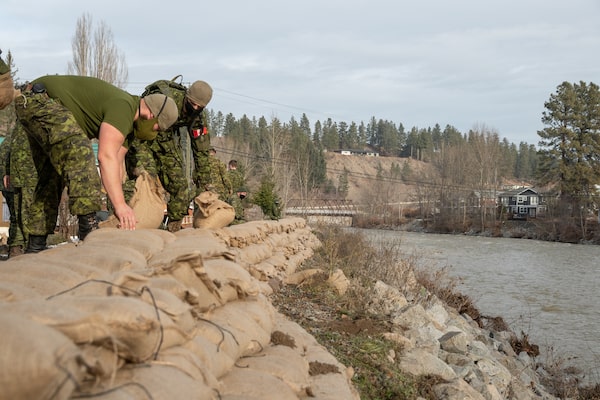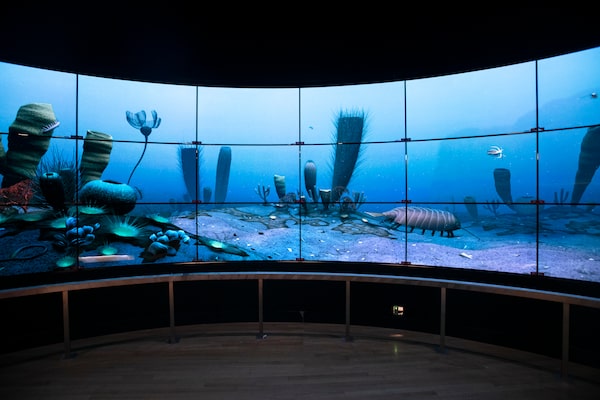Good evening, let’s start with today’s top stories:
Canada has no plans to send additional troops to Ukraine amid its escalating border crisis with Russia, as the head of the Canadian military acknowledged worries that an expanded NATO presence in Ukraine could provoke, rather than deter, Russian President Vladimir Putin.
There are widespread fears that Putin – who has amassed an invasion-sized force near his country’s borders with Ukraine for the second time this year – may be considering wider military action against Russia’s neighbour, which Moscow has been trying to wrest back into its orbit since a pro-Western revolution in Kyiv seven years ago.
The Globe and Mail reported last week that Canada was considering a show of support for Ukraine in the crisis, possibly by sending additional troops to bolster the 200-soldier Operation Unifier training mission, or by sailing a Canadian warship into the Black Sea.
However, Chief of Defence Staff General Wayne Eyre said during a Thursday visit to Kyiv that he was concerned that any new military backing for Ukraine could inflame the situation. Putin recently stated that any expansion of the U.S.-led North Atlantic Treaty Organization’s presence in the country would cross a “red line” for Russia, which considers Ukraine to be part of its so-called “sphere of influence.”
Read more: Ukrainian President Zelensky had warned of coup plot. Protesters now warn of his political ploy
A serviceman of the Ukrainian Armed Forces takes part in military drills at a training ground near the border with Russian-annexed Crimea in Kherson region, Ukraine, in this handout picture released by the General Staff of the Armed Forces of Ukraine press service Nov. 17, 2021.Armed Forces of Ukraine/Reuters
Air travellers could wait up to three days in isolation for on-arrival COVID-19 test result in Canada
Travellers arriving in Canada from countries other than the United States can expect to isolate for as many as three days while they wait for their COVID-19 test results, part of Ottawa’s evolving strategy to slow the spread of the Omicron variant.
The new on-arrival testing rule for air travellers was first announced Tuesday in a suite of new measures. However, the details of its implementation were still foggy Wednesday, with the country’s major airports waiting for more information and the government not saying when the rule will be fully in place.
Health Minister Jean-Yves Duclos said travellers will either be tested at the airport or given one to take at home in isolation. He said the expected “service standard” to receive a test result is three days, but at the moment the majority of tests come back in a day. That could change, he cautioned, as the government increases the number of travellers being tested by more than 50 per cent.
The government said the on-arrival test and isolation rule will apply to all travellers who have been in a country other than the U.S. in the past 14 days – even if they arrive in Canada via the U.S.
Read more: Canada’s Omicron travel bans and proof-of-vaccination rules explained
Passengers that recently arrived at Toronto Pearson International Airport, are photographed on Oct 15, 2021.Fred Lum/the Globe and Mail
Were B.C.’s dikes ever up to the job of stopping floods like these?
For years, experts had been warning about weaknesses in the network of more than 1,100 kilometres of anti-flood fortifications – but fear of cost and lack of maintenance left many problems unsolved before it was too late.
Reports predicting dike failures in B.C. go back decades. One of the most recent, a report for the Fraser Basin Council from March, 2021, concluded that “most of the dikes in the province do not fully meet provincial standards” and would likely breach even during relatively weak storms. Many haven’t been properly maintained and suffer from known defects. The fragility of the infrastructure was highlighted even earlier; a 2013 report commissioned by the province estimated over two-thirds of them were in “poor to fair” condition, while 18 per cent were labelled “unacceptable.”
They’re certainly inadequate in the face of a rapidly changing climate, and as torrential rain continued to pound B.C. this week, and Abbotsford remains under evacuation orders, the state of the province’s dikes has become an increasingly urgent concern.

Members of A Squadron, Lord Strathcona's Horse, lay sandbags along the Tulameen River to reinforce a section of Princeton's dike on Nov. 27, 2021.Caillum Smith/The Globe and Mail
This is the daily Evening Update newsletter. If you’re reading this on the web, or it was sent to you as a forward, you can sign up for Evening Update and more than 20 more Globe newsletters here. If you like what you see, please share it with your friends.
ALSO ON OUR RADAR
Canada Goose comes under fire again from Chinese state media, regulators after returns policy sparks furor: Luxury parka-maker Canada Goose is facing renewed scrutiny in China from state media and regulators, months after it was fined for allegedly misleading advertising.
Does Sacramento’s plan to make housing a right empower the homeless or just corral them?: The push to make housing a right has now thrust the city into one of the most fierce debates on what the U.S. owes its vulnerable, and what it can demand from them in exchange. Advocates for the homeless call the proposed right a disguised effort to corral the homeless. Business interests, meanwhile, worry the ordinance will bring the city to its financial knees.
TD Bank raises dividend 13%, plans share buyback as profit tops expectations: Toronto-Dominion Bank reported higher fourth-quarter profit excluding one-time items and raised its dividend by 13 per cent, driven by solid returns from retail banking and a large recovery from its reserves against loan losses.
Ontario, Alberta expanding eligibility of COVID-19 booster shots for adults amid rising case counts: Provinces are expanding eligibility for third-dose COVID-19 booster shots, part of contingency plans designed to mitigate the damage of a possible surge in cases over the winter months.
Listen to The Decibel: Why this was the moment for Barbados to leave the monarchy
MARKET WATCH
A broad rally sent North American stocks to a sharply higher close on Thursday, recovering ground lost over recent sessions as market participants snapped up bargains while digesting the implications of a shifting pandemic.
All three U.S. indexes advanced, with investors favoring value over growth, and economically sensitive smallcaps and transports outperforming the broader market. Of the three, the Dow gained the most with Boeing Co providing the biggest lift to the blue-chip industrial average. Canada’s TSX gained 1.45 per cent, although the gold sector was left out of the rally.
According to preliminary data, the S&P 500 gained 63.46 points, or 1.41 per cent, to end at 4,576.50 points, while the Nasdaq Composite gained 128.78 points, or 0.84 per cent, to 15,382.83. The Dow Jones Industrial Average rose 622.37 points, or 1.83 per cent, to 34,644.41. All 11 major sectors of the S&P 500 closed in positive territory.
Got a news tip that you’d like us to look into? E-mail us at tips@globeandmail.com. Need to share documents securely? Reach out via SecureDrop.
TALKING POINTS
Lower the voting age? You could make just as good an argument for raising it
“We do not impose any similar test of intellectual capacity on adult voters. You can vote if you are illiterate, or mentally ill, or drunk, or senescent: the only requirement is that you be 18 and a citizen. If we aren’t willing to discriminate between adults in this regard, it’s unclear why we should be any more willing to discriminate between adults and children – or between children of different ages.” – Andrew Coyne
Canada’s Omicron border choice: act now – or never
“You don’t dive headfirst into a lake if you can’t see how deep it is. You don’t floor the gas pedal when whiteout conditions hide the road. And you don’t blindly open your border if you lack the tools to confirm that those crossing it aren’t carrying the latest version of COVID-19.” – The Editorial Board
Pharmaceutical costs are soaring due to innovative but pricey new drugs
“Despite novel drugs providing new treatment options, without rapid change in how we manage drug costs nationally, public and private insurers will have difficulty absorbing these costs.” – Mina Tadrous, Tara Gomes and Michael Law
With bid to revive hockey, François Legault finds another way to wrap himself in the Quebec flag
“While many politicians get isolated once in power, Quebec Premier François Legault keeps his fingers on the pulse of the Québécois nation like few who came before him. And what nags at the Québécois consciousness these days – besides the pandemic, inflation, demographic decline and the future of the French language – is the sorry state of hockey in the province that gave the world the likes of Maurice Richard, Jean Béliveau, Guy Lafleur, Mario Lemieux and Patrick Roy.” – Konrad Yakabuski
Coming soon: a big, hairy fight over health care funding
“We’re at something of an impasse. The provinces see Ottawa handing Quebec $6-billion for child care but without conditions and wonder why they are getting treated differently. It’s almost like some of these premiers are new to this place called Canada.” – Gary Mason
LIVING BETTER
Should ‘heart-rate variability’ guide the intensity of your workout?
You’re scheduled to do a big workout today – maybe it’s a long run, maybe it’s Leg Day – but you don’t have the usual bounce in your step. Maybe you should just take it easy, let your body recover and go hard tomorrow. Would that be a smart move, or just lazy?
That’s a tricky decision even for elite athletes, and sports scientists have long sought some sort of impartial biomarker that would reveal whether you’re sufficiently recovered to train hard again. After experiments with options ranging from brain waves to body temperature, the hottest candidate these days is a parameter called “heart-rate variability,” or HRV – and a new review in the Journal of Science and Medicine in Sport gives it a cautious endorsement.
TODAY’S LONG READ
New ROM gallery showcases the weird, wonderful first drafts of animal life on Earth

A large wall of video screens that depicts a Cambrian sea. Opening on Dec 4, 2021, exhibits at the Royal Ontario Museum’s Willner Madge Gallery, Dawn of Life show, is photographed on Nov. 25, 2021.Fred Lum/The Globe and Mail
With the opening of a new permanent gallery at the Royal Ontario Museum, dubbed “The Dawn of Life,” Jean-Bernard Caron, curator of invertebrate paleontology at the ROM, is aiming to transform our understanding of evolution’s amazing journey before the dinosaurs came along – and long before mammoths, sabre tooth cats and our own primate ancestors were on the scene.
This is not simply the first chapter of life as we know it – more like the first several volumes of a rich drama that highlights some of biology’s greatest innovations, as championed by a cast of bizarre-looking heroes with unfamiliar names.
Yet it is these creatures that pioneered what it means to be an animal on Earth. As alien as they may appear to human eyes, they were the ones who made the first moves, caught the first glimpses, breathed the first breaths and took the first steps. Along the way, they invented exploring, socializing, protecting the next generation and the intricate, interdependent game of predator and prey. With virtually everything we do, we draw on their legacy.
Evening Update is written by Emerald Bensadoun. If you’d like to receive this newsletter by e-mail every weekday evening, go here to sign up. If you have any feedback, send us a note.